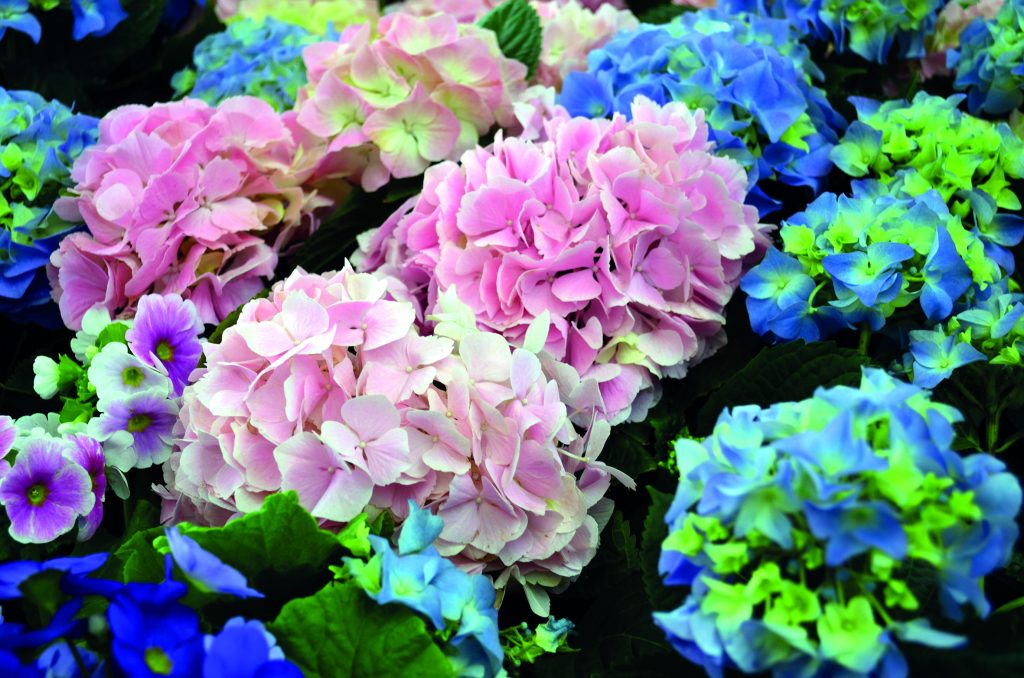
Hydrangeas are gorgeous shrubs – their great mounds of delicate yet showy flowers often take on pinky hues into autumn and can be dried for winter use too. There are masses of varieties, colours and sizes to choose from. Here’s my pick:
Hydrangea Macrophylla
H.macrophylla go pink in alkaline and blue in acidic soil. To guarantee colour – go for white. There are two types, mophead, with large, globular heads and lacecap with flattened heads of tiny flowers surrounded by sterile florets. They’re happiest in part shade but can take sun – and like to be kept hydrated.
- Macrophylla ‘Madame Emile Mouillere’
A flamboyant white mophead becoming pink tinged into autumn– great for lighting up a partly shady border.
- Macrophylla ‘Westfalen’
A compact cultivar with bright green leaves and large rich purple mophead blooms. Good for smaller gardens.
- Macrophylla ‘Veitchii’
A small, elegant and hardy lacecap hydrangea with white sterile florets, that turn pink as they age.
- Macrophylla ‘Rotchwanz’
A more unusual lacecap with deep pink to wine-colored starry flowers and dark green leaves flushed red. A stunner.
Hydrangea paniculata
Hydrangea paniculata have longer conical shaped flowers and add colour later in the season. They’re happiest in rich soils with partial sun.
- Paniculata ‘Limelight’
A popular hydrangea with heads of lime-green flowers that fade to cream then deep pink in autumn. ‘Little Lime’, is a compact version ideal for smaller gardens.
- Paniculata ‘Tardiva’
Lovely late flowering hydrangea with creamy-white flowers – good for a large sheltered border.
- Paniculata Pinky Winky
A very pretty variety has elongated heads of flowers that turn pink from the base – giving the flowers a two-tone effect. I’ve seen it looking great in a patio container.
- Paniculata ‘Vanille Fraise’
A popular variety with large creamy white flower heads turning pink and then russet red in autumn. Loose and spreading in habit.
- Paniculata ‘Kyushu’
A dainty hydrangea, perfect for pots.
Other:
Arborescens hydrangeas, from America, can tolerate hotter dryer conditions. Best loved is H. ‘Annabelle’ with huge globes of fresh lacy cream-coloured flowers. ‘Strong Annabelle’ is new variety with tougher stems.
The oak leaved hydrangea H. Quercifolia is another American variety with oak leaved shaped leaves that turn a dramatic pinky red. ‘Snow Queen’ has large cones of white flowers. With a spreading habit it’s best in a partly shady border with space.
Hydrangea care:
Planting: Add plenty of organic material such as garden compost to help retain moisture.
Watering: Water well in first season and in dry summers tip a bucket of water over the roots about once a week.
Pruning: In spring cut back flowering stems to within a few buds of the woody framework, then mulch.
Drying: Pick at their peak or as they fade.
Feeding: Use a slow-release fertiliser or sprinkle blood, fish and bone in spring. If leaves are yellowing, water with liquid seaweed.
Staking: Fluted plants support placed over the plant in early spring, or bamboo canes tied gently to floppy steams will help keep plants upright.
Companions: Under plant with Liriope muscari, Vinca minor or Geranium ‘Rozanne’. Dark dramatic flower such as penstemon ‘Raven’ or Clematis ‘Black Prince’ contrast well with white hydrangea varieties. Or go for spire shaped perennials such as Veronicastrum virginicum ‘Album’, or perovskia ‘Blue Spire’.
Follow Janine on instagram @janinewinlaw
This article first appeared in the August 2017 issue of SE22 magazine.

